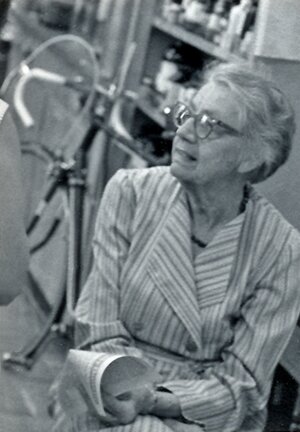
Ruth Eliza Okey, first woman PhD graduate in the Department of Chemistry at Illinois
In the early 1900s, Ruth Eliza Okey attended Monmouth College in Monmouth, Ohio, to major in chemistry, “because she liked it.” She also majored in German, because she was told “no woman could make a living as a chemist,” Okey recalled in an autobiographical essay that was published in the Journal of Nutrition after her death in 1987 at the age of 94.
From Monmouth, Okey went on to become the first woman to graduate from the University of Illinois with a PhD in chemistry in 1918, after earning her MS at Illinois three years prior in 1915, both under Professor George D. Beal.
Her doctorate research focused on the organic chemistry of plant glycosides. She was also a teaching assistant in chemistry and qualitative analysis, and after her doctorate, was appointed an instructor in physiological chemistry at Illinois.
Her appointment at Illinois didn’t last long. As she explained in her essay, women were needed in chemistry departments during World War I, but “with the return of chemically trained men from the service, the situation changed.”
So, in 1919, Okey moved west to be an assistant professor in a new department at the University of California-Berkeley, the Department of Household Science.
Much of Okey’s academic career is detailed in a 1993 In Memoriam that was written by Thomas H. Jukes, Loy Sammet and Mary Ann Williams and is included in The University of California History Digital Archives.
Ruth Okey was a woman scientist who entered a man's world and made herself at home in it, even though her professorship was in a “woman's department.” She was a pioneer in the chemistry of blood lipids, a subject which today is on everyone's mind with all the concern about cholesterol counts and diet.
Ruth was born in Ohio in 1893 and grew up in its northeastern hills on a farm which had been in the family for a century.
In 1919, she came to Berkeley as assistant professor in the new Department of Household Science. She had to adjust to transferring from one of the “best-equipped departments of biochemistry in the country (Illinois) to a department that offered only test tubes, beakers, and a few bunsen burners” in a temporary frame building. Her research budget of $250 a year “was considered extremely generous.”
The teaching load was heavy and the students were a varied lot. It was rather a surprise to have a class of ex-army nurses, who were preparing for a B.S. in public health nursing, rise and stand at attention when she met the class for her first lecture. There were also football players who were majoring in physical education.
The administration's attitude in Berkeley towards women led Ruth to leave for an assistant professorship at the University of Iowa in 1921, but things improved at Cal and she returned in 1922.
Her focus was human metabolism. The research subjects were graduate students and interested undergraduates from her classes. The projects related diet composition to the blood and urinary constituents that are used for diagnostic purposes, including iron, hemoglobin, glucose, and cholesterol. Most of this research was published between 1924 and 1933 in the Journal of Biological Chemistry.
In 1929, she had a very productive six-month sabbatical at the University of Rochester in the laboratory of W.R. Bloor, a pioneer in lipid analysis. From then on, cholesterol and lipid metabolism remained her dominant research themes. She concentrated on the effects of biotin, inositol, and choline, as well as on that of egg yolk lecithin, on the metabolism of foods containing cholesterol. She had much difficulty maintaining a lab and an animal colony. Money and equipment were in short supply. It was difficult to get authorization for purchase of such necessities as a research microscope or a good colorimeter, she remembered.
In the Fifties, Ruth was appointed chair of the nascent Department of Nutritional Sciences. “When it became evident that alterations in the building and changes in courses and in facilities for research had to be made before we could secure a full staff of the caliber required for a department of Nutritional Sciences, I was made department chairman with the idea, I suppose, that I could make the necessary changes before retirement” (June 1961).
As always, Ruth Okey fulfilled her responsibilities. She saw to it that the necessary changes were made. Most crucial were searches for new faculty and planning for new laboratory space. “Appointments with the rank of full professor were difficult to arrange, even then.”
Even when chair, Ruth Okey maintained vigorous research programs and chaired the Graduate Group in Nutrition.
In her later work, Ruth pursued another interest, that of the role of the liver in regulating plasma cholesterol, part of what is now called reverse cholesterol transport, a field of intense interest in the 1990s. A 1965 paper from her laboratory showed clearly the net uptake of plasma cholesterol by the liver.
In 1962, Ruth received the Borden Award in Human Nutrition. She was also a Fellow of the American Institute of Nutrition, a member of the American Society of Biological Chemists, and a 50-year member of the American Chemical Society.
Clearly, Ruth Okey's life reflected the fact that she was very wise when she decided to graduate in chemistry “because I liked it.”
- Thomas H. Jukes, Loy Sammet and Mary Ann Williams
In Memoriam excerpts courtesy of University of California History Digital Archives
Career Highlights of Ruth Eliza Okey
University of Illinois, instructor of physiological chemistry (1918-1919); University of California, assistant professor of household science (1919-1921, 1922-1926); University of Iowa, assistant professor of home economics (1921-1922); Experimental Station, University of California, Berkeley, associated professor and associate biochemist (1926-1944), professor and biochemist (1944-1961), emerita professor (from 1961). Awards: Borden Award (1961). Honors and memberships: American Association for the Advancement of Science; Chemical Society; Society for Biological Chemistry; Society for Experimental Biology; Home Economics Association; Dietetic Association; Institute of Nutrition.